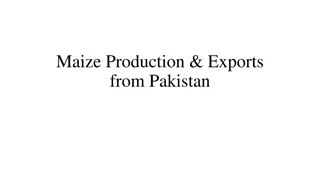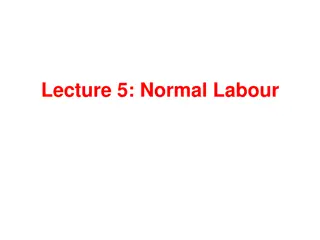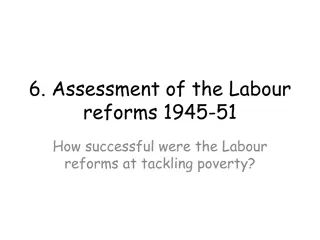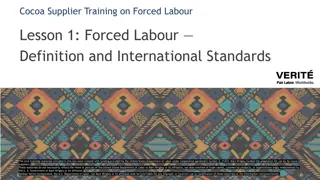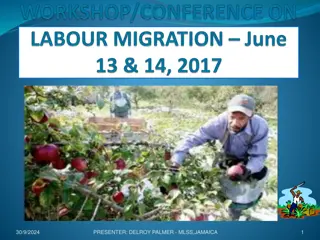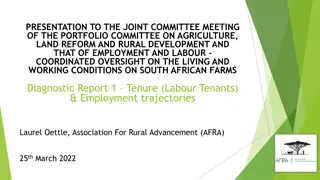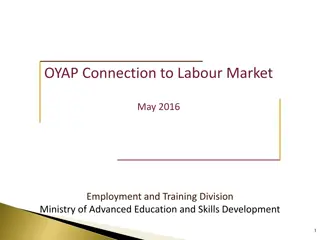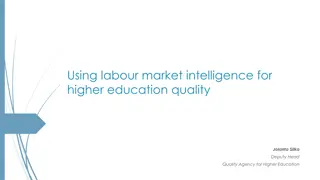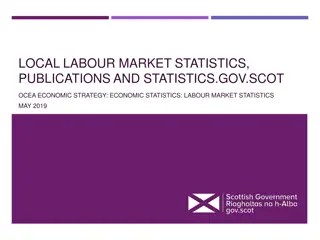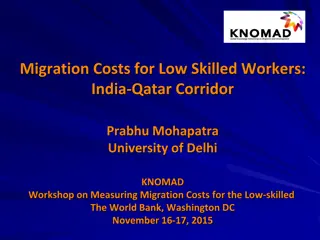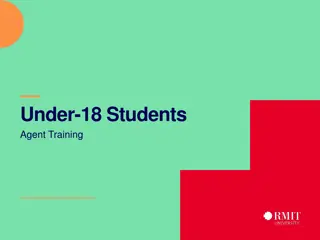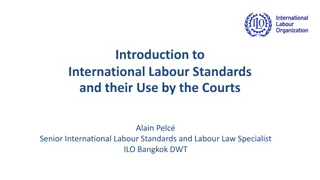Labour Welfare Initiatives in KPK
Labour welfare plays a crucial role in enhancing the well-being of workers in Khyber Pakhtunkhwa (KPK). Various programs and services are implemented to improve the working conditions and overall quality of life for laborers in the region. This article explores the definition of labour welfare, the significance of providing amenities for workers, and the ongoing efforts in KPK to promote a healthy and conducive environment for employees.
Download Presentation

Please find below an Image/Link to download the presentation.
The content on the website is provided AS IS for your information and personal use only. It may not be sold, licensed, or shared on other websites without obtaining consent from the author. Download presentation by click this link. If you encounter any issues during the download, it is possible that the publisher has removed the file from their server.
E N D
Presentation Transcript
LABOUR WELFARE IN KPK
Introduction A question that is commonly asked when two friends meet, is, What do you do for a living? Work is a central focus in our lives. Work not only enables us to earn money to pay bills and buy edibles , clothes, shelter etc. but it can also provide a sense of self- respect, a circle of
colleagues and friends, and a source of self-fulfillment. A challenging job can help us to grow intellectually, psychologically, and socially. Work also largely determines our place in the social structure. We are, to a great extent, defined by our work{1}. {1}Zestrow. C. (2000). Introduction to Social Work and Social Welfare. 7thEd: Belmont. Wadsworth Publishing Company. P. 386
In this Lecture we will talk about workers/Labourers and their welfare in KPK. What are the various programmes running for labour welfare and what services they are provided?
LABOR WELFARE The term labour welfare is very comprehensive. It involves various interpretations due to different social customs and degrees of industrialization. According to a report of the I.L.O. worker s welfare should be understood as meaning; M. Khalid. (2002). Social Work Theory and Practice with Special Reference to Pakistan. Karachi. Kifayat Academy. P.280
Such services, facilities and amenities which may be established in or in the vicinity of undertakings to enable the persons employed in them to perform their work in healthy and congenial surroundings, and provided with amenities conducive to good health and high morale.
Labour welfare may be understood to mean all measures and provisions, provided by employer in and around the factory/work place for creating better working, living and cultural conditions for the workers.
KP is a relatively poor province with average income levels (GDP per capita) estimated to be about 10% lower than in the rest of the country. The provincial economy is primarily agrarian with a limited industrial base. Labour force, as per 1998 census, of 10 years and above in NWFP is 3441776. Out of which only 2518368 number of labour force is employed. It means that the remaining 923408 number of people are unemployed giving a percentage of unemployment as 26.8. Government of NWFP. (2008). Directory of Industrial Establishment 2007, Peshawar. Industries, Commerce, Labour, Minral Dev: Technical Education Department. p-165
According to the same statistics the male and female employed labour force is 2425742 and 92626 respectively. The number of registered industrial units, as per 2007-08 statistics, is 2254 out of which only 1552 industrial units are running and which have given employment to a number of 66129 labourers (42.6 persons per industry), while remaining 702 industrial units are closed and need to be started again so as to make employment more and more.
Labour Welfare in KP
The situation of Labour Welfare in KP is dismal as the industrial base .The Various welfare programmes, the laborers have, are discussed as below;- In Labour Welfare we have some three departments in the Province; Workers Welfare Board (WWB), Employees Social Security Institutions (ESSI), and Employees Old Age Benefit Institution (EOBI).
The major concern of the Workers Welfare Board (WWB) is to provide accommodation to the workers of the Industrial Establishments, scholarships to the children of laborers and construction of folk schools in the industrial estates.
while the concern of the Employees Social Security Institutions, as is indicated by its name, is to provide social security i.e. health and other benefits.
The EOBI is a Federal Institution and it has nothing to do with the Provincial Govt. This Institution benefits in the old age the employees. In the coming slides each department will be discussed.
Employees Social Security Institutions Govt. of NWFP. (2007). Brief Concerning the NWFP, Employee's Social Security Institution. Peshawar. Employees Social Security Institution. Unpublished Document of ESSI
ESTABLISHMENT OF NWFP, EMPLOYEES SOCIAL SECURITY INSTITUTION The NWFP Employees Social Security Institution came into being on the break-up of one unit in July, 1970. Prior to the dismemberment of one Unit, the affairs of the Institution in this Province were supervised by the Head Office of the West Pakistan Employees Social Security Institution Lahore. The NWFP was having only one Local Office at Nowshera which was under the charge of Deputy Director.
The Secretary to Government of NWFP Industries Commerce Mineral Development, Labour and Technical Education Department Peshawar is the Commissioner of the Institution. He is the Chief Executive of the Institution and also acts as Secretary to the Governing Body.
The Vice Commissioner shall perform the duties of the Commissioner when the latter is absent or prevented from acting and the Commissioner may assign to the Vice Commissioner the responsibility for the direction of certain services or delegate to him any of his own powers under the Ordinance, the rules and the regulations.
The Director General Health Services (NWFP) is the Medical Advisor. The Secretary Finance Government of NWFP is the Finance Advisor of the Institution.
The Institution's Head Office is located in Peshawar. There are three local offices. The Head Office is headed by Director General while Local Office Nowshera and Haripur are under the charge of Deputy Director. The NWFP Employees Social Security Institution has been divided into three regions. Similarly the regions have been divided into sub-regions and placed under the charge of Social Security Officers
Following Directors are also working under the Director General, NWFP Employees Social Security Institution in Head Office:- Director Admn: Contribution and Benefits. Director Medical. Director Finance.
GOVERNING BODY The Governing Body of the Institution consists of the following members and Chairman:- Minister for Labour Secretary Labour & Industries Secretary/ Member Secretary Finance Secretary Health Medical Advisor (D. G. Health Services Govt: of NWFP) Two employer's representatives. Two employee's representatives. Chairman. Member. Member. (Ex-Officio ( member.) Members Members
EXTENT OF COVERAGE The Ordinance provides coverage to the areas, classes of persons working in industries or establishments from such date or dates, and with regard to the provision of such benefits as Government may, by notification, specify in this behalf.
An employee as defined in the Ordinance includes "any person employed, whether directly or through any other person for wages or otherwise to do any skilled or unskilled, supervisory, clerical, manual or other work in, or in connection with the affairs of an industry or establishment, under a contract of service or apprenticeship, whether written or oral, expressed or implied but does not include:-
(a). Persons in the service of the State, including member of the Armed Force, Police Force and Railway Servants. (b).Persons employed in any undertaking under the control of any Defense Organization or Railway Administration. (c).Persons in the service of a Local Council, a Municipal Committee, a Cantonment Board or any other local Authority. (d).Any person in the Service of his father, mother, wife, son or Daughter, or of her Husband. (e) Any person employed on wages exceeding Five Thousand per mensem (Provided that an employee shall not cease to be an employee for the reason that his monthly wages exceed Five Thousand Rupees) (now it is 10,000 Rupees) .Now after the fixation of minimum wages up to 6, 000 Rupees in 2008
The scheme is extended gradually. This Institution have covered ( 3,148 ) establishments and securing ( 45,276 ) workers with approximate ( 226,380) dependents.
B E N E F I T S The main objectives of the Social Security Scheme are to provide benefits to certain employees or their dependents including parents in the event of Sickness, Maternity, Employment Injury or Death. The benefit admissible under the scheme comprises: - Medical Care. Cash Benefits.
MEDICAL CARE The Medical Care Branch of the Institution is headed by Director Medical of the Institution. The extent of medical care for secured workers and their dependents consists of:- 1. General practitioner care. 2. Specialists care in hospital for indoor and out-door patients and specialists care as may be available outside hospitals.
Essential pharmaceutical supplies as prescribed by a medical practitioner / specialist. Hospitalization, where necessary including cases of pregnancy and confinement. Pre-natal confinement and post-natal care, either by medical practitioners or by qualified midwives. Dental care in employment injuries. The dependents receive full outdoor treatment from the medical units of the Institution.
Dependents including parents are also entitled to Hospitalization and specialist treatment. T.B. patients are entitle to the following special medical treatment:- (a). Hospitalization facilities for a total period of 6-months. (b). Out-door treatment for a period of one year from the date of entitlement.
The secured workers and their dependents are being provided medical facilities through medical units of the Institution and Government Hospitals. Specialists care has been arranged through retainer specialists and the specialists on the panel of the Institution. The Institution has also appointed its own specialists in the following fields:- .
Chest Specialist. Skin Specialist. Gynae Specialist. General Surgeons Dental Surgeon. On the advice of these Specialists the Institution also provides medical treatment to the patients outside the province in Punjab and Sindh, where these facilities are not available in this Province
SOCIAL SECURITY MEDICAL UNITS The Institution has established 25 Bedded Hospital at Industrial Estates: Gadoon, (15 bedded Poly Clinic ) Peshawar (10 bedded) 11, Medicare Centers, 5 Dispensaries and 12, Medical Posts. At the present the following specialists of the Institution are regularly attending the patients. 1. Chest Specialist. 2. Skin Specialist. 3. Surgeon (at Poly Clinic Peshawar) 4. Surgeon (at Gadoon Hospital) 5. Dental Surgeon. 6. Gynecologist.
All the Medical Units of the Institution have mostly been established in centrally located areas of the covered establishments. 18 Medical Officers , 16 Women Medical Officers and 166 Medical and Para Medical staffs are working in these medical units. The Institution has also made arrangement to provide medical care to the secured persons and their dependents at all category A hospitals in the province
AMBULANCE SERVICE The Institution has an Ambulance fleet of 24 vehicle for the evacuation of emergency cases to the nearest Government Hospitals and Specialist for Medical Care. These Ambulances remain parked at all medical units of the Institution except medical posts and are available at call round the clock.
M E D I C I N E S The Institution has its own pharmacopoeia, which is revised every year by the Committee of Senior Doctors headed by Vice Commissioner ESSI has been constituted. The Medicines are purchased on the recommendations of the Purchase Committee.
The ESSI maintains three medicines bulk stores, one each at Haripur, Nowshera and Peshawar. The distribution is made to the dispensaries on monthly basis according to the strength of workers, OPD load and budgetary allocation. Supplementary demands are also entertained and due priority is given to the supply to avoid any shortage of medicines.
CASH BENEFITS The following cash benefits are admissible under the scheme (1)Sickness Benefits . . 75% of employee s wages. (2)Maternity Benefits .100% of employee s wages. (3)Injury Benefits...........100% of employee s wages. (4)Death Grant.................................................Rs. 1500/= (5)Gratuity in Employment Injury cases. (6)Partial Disablement Pension to the secured persons incapable to work due to employment injuries. (7)Total Disablement Pension. (8) Survivor's Pension. (9)Iddat Benefit...........100% of employee s wages.
C O N T R I B U T I O N The Institution is a self supporting Autonomous Body without any aid from the Provincial or the Federal Government. It meets all the expenditures from the contribution payable by the establishments covered under the scheme @ 7% of the wages of their employees. The rate was fixed in 1976. All Medical facilities and cash benefits provided to the secured persons and their dependents including parents and all other expenditures are met from the contribution received @ 7% of the total wages paid by the employers to their employees.
All these facilities are provided to secured workers and their dependents free of any cost. Even the 2% contribution previously paid by the worker is now being paid by the employer. The workers are well represented through their two representatives in the Governing Body of the Institution who formulate the policies of the ESSI. The workers have also been given representation in the Purchase Committee of medicines. These representatives also suggest any improvement in the services provided by the ESSI.
Workers Welfare Board Govt. of NWFP. (2007). Brief Concerning NWFP Workers Welfare Board. Peshawar. Un published Document of Workers Welfare Board
It was established in 1971 in order to provide residential and educational facilities as well as other welfare measures including Jehez Fund for the marriage of the daughters of workers, merit scholarships to deserving children of industrial labor, distribution of sewing machines and bicycles. Govt. of NWFP. (2001). Introduction Workers Welfare Board. NWFP Workers Welfare Board. Retrieved September 01, 2008 from http://nwfp.gov.pk/Industries/WorkersWelfare%20Board/index.php
Organizational History Workers Welfare Board (WWB) established in the year 1974 under section 11-A of the Ordinance 1971 for the efficient management and administration of the workers welfare programmes in the Province financed out of funds allocated from the Workers Welfare Fund, Islamabad (WWF).
The Provincial Secretary Labour heads WWB as Chairman Provincial WWB. The Secretary WWB is the Executive Officer, under whose supervision, The Director Works is responsible for development of schemes/works, and Director Education looks after the schools and educational programmes.
The Deputy Secretary is looking after administrative and other welfare measures, whereas the Deputy Director Finance /Accounts) is responsible for accounts and financial matters of the WWB, Deputy Director (Education) is responsible for semi administration & financial affairs of the Directorate of Education
Functions The major functions of NWFP WWB are as following: Construction of residential colonies/houses/flats for the industrial labor. Construction of schools for the children of industrial labor. Construction of dispensaries/poly-clinics and creation of medical wards/centers in big hospitals of the Province like Kidney Center, Burn Trauma/Head Injury Center etc.
Provision of drinking water supply schemes for Mine Workers at Buner, Haripur and Abbottabad. Education/Scholarship opportunities to workers children. Jehez Fund for the marriage of daughters of workers. Distribution of sewing machines and bicycles. A Directorate of Education was also established by NWFP Workers Welfare Board in March 2000. A Workers Children Education Board is also providing free educational facilities/scholarships to the children of industrial labor.
Sources of Income The fund for WWB is provided through various sources Initial grant of Rs. 100 Million by the Federal Government to the Fund 2 % of the income assessed for the purpose of Income Tax in respect of the industrial establishments having annual income of Rs. 100,000/- or more Un-distributed portion of the Companies Profit (Workers participation) Fund of Industrial establishments
Voluntary contributions in the shape of money or Building, land or other property made to it from time to time by any Government or by any person Income from the investment made and properties and assets acquired out of the Fund Proceeds of Loans raised by the Governing body.


